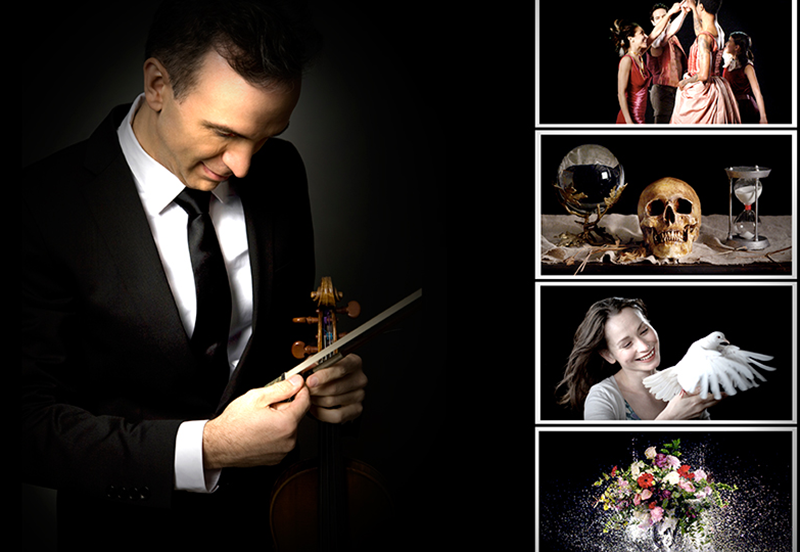You are here
Gil Shaham Bach Six Solos with original films by David Michalek
Apr 16Performance Dates
- Sat Apr 16 2016 8:00 PM
Venue
One of the foremost violinists of our time, Gil Shaham commands flawless technique with inimitable warmth, a combination that has solidified his legacy as an American master. "One of the few [violinists] identifiable by sound and style alone," according to The Boston Globe, the multiple Grammy Award winner plays the 1699 "Countess Polignac" Stradivarius. For his Meany Hall debut, Shaham will perform all six of Bach's sublime Sonatas and Partitas for Solo Violin, among the most technically demanding and emotionally penetrating works Bach ever composed, with projections of stunning visual imagery created by artist/filmmaker David Michalek.
Co-commissioned by the UW World Series
CAST
Gil Shaham
Gil Shaham is one of the foremost violinists of our time: his flawless technique combined with his inimitable warmth and generosity of spirit has solidified his renown as an American master. The Grammy Award-winner, also named Musical America’s “Instrumentalist of the Year,” is sought after throughout the world for concerto appearances with leading orchestras and conductors, and regularly gives recitals and appears with ensembles on the world’s great concert stages and at the most prestigious festivals.
Shaham headlines a Parisian-themed opening-night gala with the Seattle Symphony this fall, launching a new season that sees him rejoin the San Francisco Symphony under Michael Tilson Thomas for Mozart’s “Turkish” concerto, and, on the orchestra’s 20th-anniversary tour, for Prokofiev’s Second at venues including Carnegie Hall. The Prokofiev also serves as the vehicle for his collaboration with The Knights at the Caramoor Fall Festival, and is one of the works showcased in his long-term exploration of “Violin Concertos of the 1930s.” Now entering its sixth season, this project takes him back to the Philadelphia Orchestra for Berg’s concerto, and to both the Berlin Radio Symphony and the London Symphony Orchestra for Britten. Besides giving the world premiere performances of a new concerto by David Bruce with the San Diego Symphony, the violinist’s upcoming orchestral highlights also include Mendelssohn in Tokyo, Canada, and Luxembourg, and two Bach concertos with the Dallas Symphony. In recital, he presents Bach’s complete solo sonatas and partitas at Chicago’s Symphony Center, L.A.’s Disney Hall, and other venues in a special multimedia collaboration with photographer and video artist David Michalek.
Last season saw the release of 1930s Violin Concertos (Vol. 1), the first double album to be yielded by Shaham’s long-term programming project, which was recorded live with the New York Philharmonic, Boston Symphony, BBC Symphony, Staatskapelle Dresden, and Sejong. In live performance, he played 1930s concertos by Bartók, Prokofiev, Barber, Berg, and Britten with such eminent ensembles as the Los Angeles Philharmonic, San Francisco Symphony, Berlin Radio Symphony, Bavarian Radio Symphony, and Carnegie Hall’s National Youth Orchestra of the USA, which he joined as guest soloist on its inaugural national tour. Among his other orchestral collaborations, Shaham reprised Korngold’s concerto, of which he has long been recognized as one of the foremost exponents, with the Vienna Philharmonic at Carnegie Hall and with orchestras including the National Symphony, Cleveland Orchestra, and France’s Orchestre de Paris, as well as giving the world, Asian, and European premieres of a new concerto by Bright Sheng. Shaham also gave his signature recitals of unaccompanied Bach in Baltimore, Cleveland, and on tour in Italy.
Gil Shaham already has more than two dozen concerto and solo CDs to his name, including bestsellers that have ascended the record charts in the U.S. and abroad. These recordings have earned prestigious awards, including multiple Grammys, a Grand Prix du Disque, Diapason d’Or, and Gramophone Editor’s Choice. His recent recordings are issued on the Canary Classics label, which he founded in 2004. They comprise Haydn Violin Concertos and Mendelssohn’s Octet with the Sejong Soloists; Sarasate: Virtuoso Violin Works with Adele Anthony, Akira Eguchi, and Orquesta Sinfónica de Castilla y León; Elgar’s Violin Concerto with the Chicago Symphony Orchestra and David Zinman; The Butterfly Lovers and Tchaikovsky’s Violin Concerto with the Singapore Symphony; Tchaikovsky’s Piano Trio in A with Yefim Bronfman and cellist Truls Mork; The Prokofiev Album and Mozart in Paris, both with his sister, pianist Orli Shaham; The Fauré Album with Akira Eguchi and cellist Brinton Smith; and Nigunim: Hebrew Melodies, also recorded with Orli Shaham, which features the world premiere recording of a sonata written for the violinist by Avner Dorman. Upcoming titles include Bach’s complete works for solo violin.
Shaham was born in Champaign-Urbana, Illinois, in 1971. He moved with his parents to Israel, where he began violin studies with Samuel Bernstein of the Rubin Academy of Music at the age of seven, receiving annual scholarships from the America-Israel Cultural Foundation. In 1981, while studying with Haim Taub in Jerusalem, he made debuts with the Jerusalem Symphony and the Israel Philharmonic. That same year he began his studies with Dorothy DeLay and Jens Ellermann at Aspen. In 1982, after taking first prize in Israel’s Claremont Competition, he became a scholarship student at Juilliard, where he worked with DeLay and Hyo Kang. He also studied at Columbia University.
Gil Shaham was awarded an Avery Fisher Career Grant in 1990, and in 2008 he received the coveted Avery Fisher Prize. In 2012, he was named “Instrumentalist of the Year” by Musical America, which cited the “special kind of humanism” with which his performances are imbued. He plays the 1699 “Countess Polignac” Stradivarius, and lives in New York City with his wife, violinist Adele Anthony, and their three children.
David Michalek
David Michalek is an artist who takes the concept and techniques of portraiture as the starting points for the creation of his works, on both a large and small-scale, in a range of mediums. His focus over the past ten years has been closely tied to his interest in relational aesthetics—specifically using performative and interactive techniques—storytelling, dialogue, movement—relying on the input and responses of others—subjects, collaborators, and audience—as integral to both the creation and the experience of his art. He has been drawn in particular to projects that bring together diverse groups of people in settings ranging from galleries to public spaces, from community organizations to health-care facilities.
His 14 Stations is one such project, created in collaboration with men and women transitioning out of homelessness, participating in the Interfaith Assembly on Homelessness and Housing at the Cathedral of St. John the Divine in New York. 14 Stations is modeled on the traditional Christian devotional rite, The Stations of the Cross, with a different man or woman assuming the role of the Christ figure in each. Group interaction, discussion, and communal meals were all part of the process.
Michalek's oversized black-and-white photos, mounted on back-lit displays have been not only exhibited in galleries and museums, but have also served as the catalyst for interactive performance events in a number of cities, involving the homeless and formerly homeless interacting with the audience and participating in a performance of Bach piano works that incorporates projected stills of 14 Stations. Covering the 2005 exhibit of 14 Stations at The Brooklyn Museum, Art in America said, "Michalek's commiseration with his fellow humans and deep understanding of dramatic figurative representation have enabled him to produce a profound cycle of photographs."
Commissioned to create the images for the film in Peter Sellar's Kafka Fragments, a staged setting of composer Gyorgy Kurtag's searing work for soprano and violin, Michalek, then Artist-in-Residence at The Bridge, Inc., a day-home for people living with mental illness, drew on his activities and interactions with patients to create his compelling photographs. Michalek introduced Kurtag's libretto at the residents' weekly poetry group, where it was read aloud and discussed. Out of these discussions, and over four months of work, he and the group staged and photographed scenes and tableaux for each of the 40 fragments of text that are sung by soprano Dawn Upshaw.
The Los Angeles Times, reviewing the 2005 performance of Kafka Fragments at Zankel Hall, wrote, "Kafka Fragments reveals the hidden places where light shines within the darkest recesses of our souls...[and the] photographs by David Michalek connect the musical fragments to suffering in the world and also to the beauty of the world."
In the summer of 2007, Lincoln Center Festival presented the premier of Michalek's Slow Dancing—a free outdoor, multi-channel video installation of hyper-slow-motion video portraits projected nightly on the facade of the New York State Theater—capturing the beauty of the body in motion by depicting movement of dance icons at 1,000 frames per second. The work was also presented at the Paris Opera Bastille, the Venice Biennale and in London’s Trafalgar Squarethe as well as at the Los Angeles Music Center, the New York Guggenheim Museum, "Works and Process," and the Metropolitan Museum of Art where it was part of a program entitled, "Artful Time: Dancing Tableaux Vivants." The New York Times, reviewing the Lincoln Center premier, wrote, "...an unforgettable dance-meets-film-technology evening. Each dance contains its own revelation of energy, phrasing, stillness and style; and the juxtaposition, different on each night, of three simultaneous dances is always enthralling;" and The New York Sun, "this latest item of public art integrates itself into the poetry of the summer of 2007, as well as the collective memories and mythology of New York City."
David Michalek earned a B.A. in English Literature from U.C.L.A. and also studied filmmaking at NYU. He worked as an assistant to noted photographer Herb Ritts for two years. Beginning in the mid-1990s, he began his professional photographic career and worked regularly as a portrait artist for publications such as The New Yorker, Vanity Fair, Interview, and Vogue. Concurrently, Michalek began experimenting with performance and installation, and developing large-scale, multi-dimensional projects. His solo and collaborative work has been shown nationally and internationally, with recent solo exhibitions at Yale University, The Brooklyn Museum, and The Kitchen. He has collaborated with director Peter Sellars on two staged works: Kafka Fragments, presented as part of Carnegie Hall's 2005-06 season; and St. François d'Assise, presented at the Salzburg Festival and Paris Opera. Other film and video work for theater includes collaborations with The Tallis Scholars; John Malpede and L.A.P.D. on three works, Agents and Assets, The Skid Row Museum, and RFK in EKY; and with the Brooklyn Philharmonic in a project for The Brooklyn Museum's "Music Off the Walls" series. Michalek has been the recipient of numerous grants and fellowships, from, among others, The Franklin Furnace, The Durfee Foundation, The California State Arts Council, the Jerome Robbins Foundation, Karen-Weiss Foundation, and the Performing Arts Center of Los Angeles County (commission grant toward the creation of Slow Dancing). Beginning in spring 2007, he will be an artist in residence with The World Performance Project at Yale University. He is a visiting faculty member at Yale Divinity School, where he lectures on religion and the arts. David Michalek lives in New York with his wife Wendy Whelan, principal dancer of New York City Ballet.


